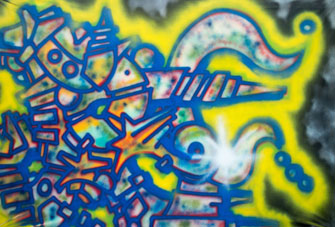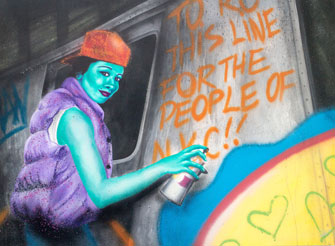The Writing on the Wall
Moves to Canvas

“Untitled” (1985), by Phase 2. © Photo: Pierre Guillien-Studio Objectivement
“Pressionism: Masterpieces of Graffiti on Canvas, from Basquiat to Bando,” an exhibition at the Paris Pinacothèque, charts the emergence and early development of graffiti art, from the streets and trains of New York city in the early 1970s to those of Paris in the ’80s, and then on throughout Europe, making the case for urban/graffiti art as an avant-garde movement comparable to others, like Impressionism at the end of the 19th century, that were initially rejected by the arbiters of good taste and the artistic establishment.
Mention graffiti and most people think of tag-scrawled trains and spray-painted city streets, hermetic underground language or mindless vandalism, take your pick. But in 1970s New York, a generation of graffers emerged who saw themselves as artists and took to canvas to give their work a longer lifespan than that offered by walls and subways. Among them, Jean-Michel Basquiat and Keith Haring were picked up by the contemporary art world and made their way into private collections and museums, but many lesser-known masters of spray-can painting have their own devout followings among the mostly (but not always) youthful cognoscenti.
The pioneers of graffiti were mostly marginalized minority kids from mean streets, self-taught and using their spray cans to express themselves in their own way as a consciously unruly underclass. The skill of painting with a spray can should not be underestimated, however. Try it yourself. It takes maybe five years of practice to produce anything remotely beautiful, says Marc Restellini, director of the Pinacothèque, in the exhibition catalogue.
The Pinacothèque show is the third major museum exhibition of graffiti/street art in Paris, following “Le TAG au Grand Palais” and “Born in the Streets: Grafitti” at the Cartier Foundation, both in 2009. In giving a new name – Pressionism – to spray-can painting, it stakes the medium’s claim to a place in mainstream art history and validates the

“Self-portrait” (1992), by Lady Pink (Sandra Fabara). © Photo: Pierre Guillien-Studio Objective-ment
virtuosity and artistry in the canvases of such artists as Rammellzee, Toxic, Quik, Bando, Phase 2 and Lady Pink.
The first rooms show how the tag – a simple signature – developed into a type of calligraphy based on infilled lettering, followed by the addition of figurative elements and full-on figurative painting in the works of artists such as Mode 2, Noc 167 and T. Kid. Later comes the arcane complexity of “wild-style” writing, which opened the way to abstractionism in the work of painters such as Futura.
Architect Alain-Dominique Gallizia, an art collector and graffiti expert who curated both the TAG show and this exhibition, notes that “graffiti artists carried out an artistic battle among themselves, an aesthetic joust in which inventiveness and a style’s originality were the only weapons.” He compares the hierarchical movement, with its masters and schools, to traditional medieval illustrators.
The exhibition explains how the works on canvas were the product of meticulous preparation, composed from preparatory sketches in the artists’ “black books” – style libraries that each artist built up over the years. Some of these can be seen in the exhibition.
The show’s narrative focuses on the connection between artists in Manhattan and Paris’s Saint Germain-des-Prés, personified by the Franco-American graffiti artist Philippe Lehman, a.k.a. Bando. A rebellious member of the Lehman

“Manifeste” (1984), by BANDO (Philippe Lehman). © Photo: Pierre Guillien-Studio Objectivement
banking family, he brought the American stars to Paris in the early ’80s and exposed them to a sophisticated collecting public in France and the neighboring Benelux countries. Discovering a culture more accepting of outsider art than their native New York, many of them, such as Jonone and SEEN, chose to settle here.
The exhibition includes many early works that were shown by the pioneering Sidney Janis and Tony Shefarzi galleries in New York in the ’80s. It also includes works from a groundbreaking Paris show put together by the fashion designer Agnès B, herself a keen graffiti fan, in 1989. As for Basquiat, whose name is mentioned in the exhibition’s title, only a couple of minor works are on show.
This art, with its vibrant colors and high energy, is mesmerizing and at times overwhelming. The small, convoluted spaces of the Pinacothèque hardly do justice to the often monumental canvases, but it’s a rare treat to see so many masterpieces, often loaned from private collections, together under one roof.
Pinacothèque de Paris: 28, place de la Madeleine, 75008 Paris. Métro: Madeleine. Tel.: 01 42 68 02 01. Open daily 10:30 a.m.-6:30 p.m. (until 8:30 p.m. on Wednesday and Friday). Admission: €13. Through September 13, 2015. www.pinacotheque.com
Reader reaction: Click here to respond to this article (your response may be published on this page and is subject to editing).
Please support Paris Update by ordering books from Paris Update’s Amazon store at no extra cost. Click on your preferred Amazon location: U.K., France, U.S.
More reviews of Paris art shows.
© 2015 Paris Update
Favorite